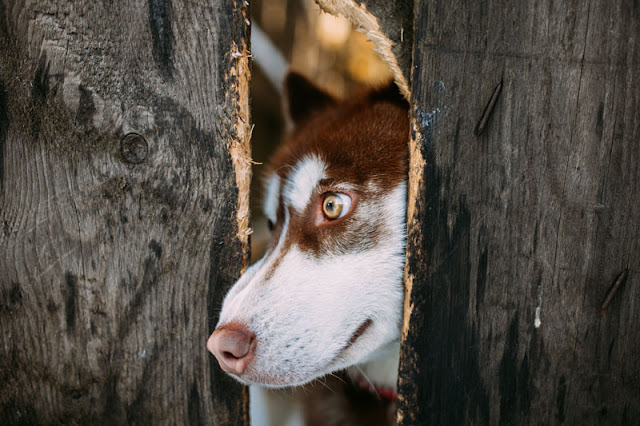Why Our Pets Need The Right to Walk Away
What can pet owners learn from the way
scientists give animals choices in research?
In Erica Feuerbacher and Clive Wynne’s (2015) experiments to test whether dogs prefer petting or praise, dogs were given time
to get used to the location and experimenter, and shown that one person was
offering petting and another praise. Then the dog was taken to the starting
position. They write that four dogs “were dropped from the experiment because
they did not approach either alternative in the first 5 min period.”
Choices are especially important for
fearful animals, for whom enforced interactions might only make the fear worse.
If your puppy is shy in class and wants to hide, let her, and she will come out in her own time. If your dog is afraid of fireworks, comfort him if he would like it or let him hide if he prefers – and later on, figure out a plan to help him with this fear. See eight tips to help fearful dogs feel safe for some ideas.
If your cats prefer to hide under the bed when young children come to visit, that’s fine too – let them stay in their safe place until things are back to normal, if that’s what they want.
Feuerbacher, E., & Wynne, C. (2015). Shut up and pet me! Domestic dogs (Canis lupus familiaris) prefer petting to vocal praise in concurrent and single-alternative choice procedures Behavioural Processes, 110, 47-59
Merola I, Prato-Previde E, & Marshall-Pescini S (2012). Dogs' social referencing towards owners and strangers. PloS one, 7 (10) PMID: 23071828
Describing dog training: Weasel words or clear descriptions?
Do dogs prefer petting or praise?
As an Amazon Associate I earn from qualifying purchases.
By Zazie Todd, PhD
This page contains affiliate links which means I may earn a commission on qualifying purchases at no cost to you.
This page contains affiliate links which means I may earn a commission on qualifying purchases at no cost to you.
When people take part in research,
scientists must ensure they give informed consent. When the participants are pets,
owners give consent on their behalf: they understand the risks of the research and
they have the right to end their participation at any time (e.g. if they feel their
dog is stressed). We can’t ask animals about their feelings, but scientists
have several ways they give the pets a choice.
In Sarah Ellis et al’s recent (2015) paper on feline stroking preferences, cats were stroked in their own homes by two different people and were free to
walk away at any time. 18 out of 34 cats walked away at some point during the
first study, and 3 out of 20 in the second study, showing the importance of the choice.
Sometimes scientists offer dogs a piece of
food before starting an experiment, or wait for the dog to approach a person or
location. Dogs are first given time to get used to the experimenters and the
new surroundings. Then if they don’t want the food or approach, it could be
because they are stressed (stressed animals are often not interested in food).
It’s not unusual for a few dogs to drop out of a study for this reason.
Just as in Ellis’s study with cats, dogs
could walk away from petting at any point in the study. Because the study was
about choices, they write that, “When providing petting, the assistant petted
and scratched the dog with one hand on the side closest to the assistant so
that the petting did not interfere with the dog’s ability to move away.”
Dogs aren’t only dropped from studies due
to lack of interest or stress; sometimes they are actually excluded for being too confident. An
example is Isabella Merola et al’s (2012)
study of whether pet dogs look to a person (their owner or a stranger) for social support when stressed by something. The scientists chose a fan with
streamers attached as the slightly-scary object. Of the 90 dogs that took part, 25 were
excluded from the study because they confidently approached the fan.
Note that dogs were never forced to go near
the fan; they were free to move around the room so they could approach, or not,
as they wished. At the end of the study, dogs were given food near the fan so they
would not be frightened of fans in future.
What is the relevance to ordinary pet owners? Try to ensure that your dog or cat (or rabbit or …) has the opportunity to make choices. If they don’t want to interact with you at a particular time, that’s fine. Wait, and try again later.
What is the relevance to ordinary pet owners? Try to ensure that your dog or cat (or rabbit or …) has the opportunity to make choices. If they don’t want to interact with you at a particular time, that’s fine. Wait, and try again later.
While to many this may seem obvious, to
others it’s a revolutionary idea. One of the (many) problems with outdated
dominance views of training is the emphasis on forcing animals to do as you
wish.
Not only is this ethically questionable, it can backfire in several ways. It is potentially dangerous for the person and animal, and risks creating fear and a poor human-animal relationship.
Not only is this ethically questionable, it can backfire in several ways. It is potentially dangerous for the person and animal, and risks creating fear and a poor human-animal relationship.
 |
| Photo: Adya/Shutterstock |
If your puppy is shy in class and wants to hide, let her, and she will come out in her own time. If your dog is afraid of fireworks, comfort him if he would like it or let him hide if he prefers – and later on, figure out a plan to help him with this fear. See eight tips to help fearful dogs feel safe for some ideas.
If your cats prefer to hide under the bed when young children come to visit, that’s fine too – let them stay in their safe place until things are back to normal, if that’s what they want.
If pets don’t want to be trained at a
particular moment in time, that’s okay – but consider how you can motivate
them in future.
Some people are surprisingly reluctant to use food for training, but think about how much dogs like to eat! You could use high value food such as your dog’s favourite treats, pieces of hot dog, cheese, fish, or even steak.
Some people are surprisingly reluctant to use food for training, but think about how much dogs like to eat! You could use high value food such as your dog’s favourite treats, pieces of hot dog, cheese, fish, or even steak.
Dog training is an unlicensed profession,
so there is no requirement for dog trainers to follow the same ethical
standards as scientists. Ask your dog trainer how they motivate dogs, and if
the answer is not food, you might like to exercise your own right to walk away.
If you like this post, check out my book Wag: The Science of Making Your Dog Happy . Modern Dog calls it “The must-have guide to improving your dog’s life.”
. Modern Dog calls it “The must-have guide to improving your dog’s life.”
If you're a cat person, you might like to check out my book Purr: The Science of Making Your Cat Happy. Dr. Sarah Ellis says, "Purr is definitely a book your cat would want you to read!"
How do you give your pets choices?
References
Ellis, S., Thompson, H., Guijarro, C., & Zulch, H. (2014). The influence of body region, handler familiarity and order of region handled on the domestic cat's response to being stroked Applied Animal Behaviour Science Feuerbacher, E., & Wynne, C. (2015). Shut up and pet me! Domestic dogs (Canis lupus familiaris) prefer petting to vocal praise in concurrent and single-alternative choice procedures Behavioural Processes, 110, 47-59
Merola I, Prato-Previde E, & Marshall-Pescini S (2012). Dogs' social referencing towards owners and strangers. PloS one, 7 (10) PMID: 23071828
You might also like:
How many dogs is enough for canine science?Describing dog training: Weasel words or clear descriptions?
Do dogs prefer petting or praise?
As an Amazon Associate I earn from qualifying purchases.






